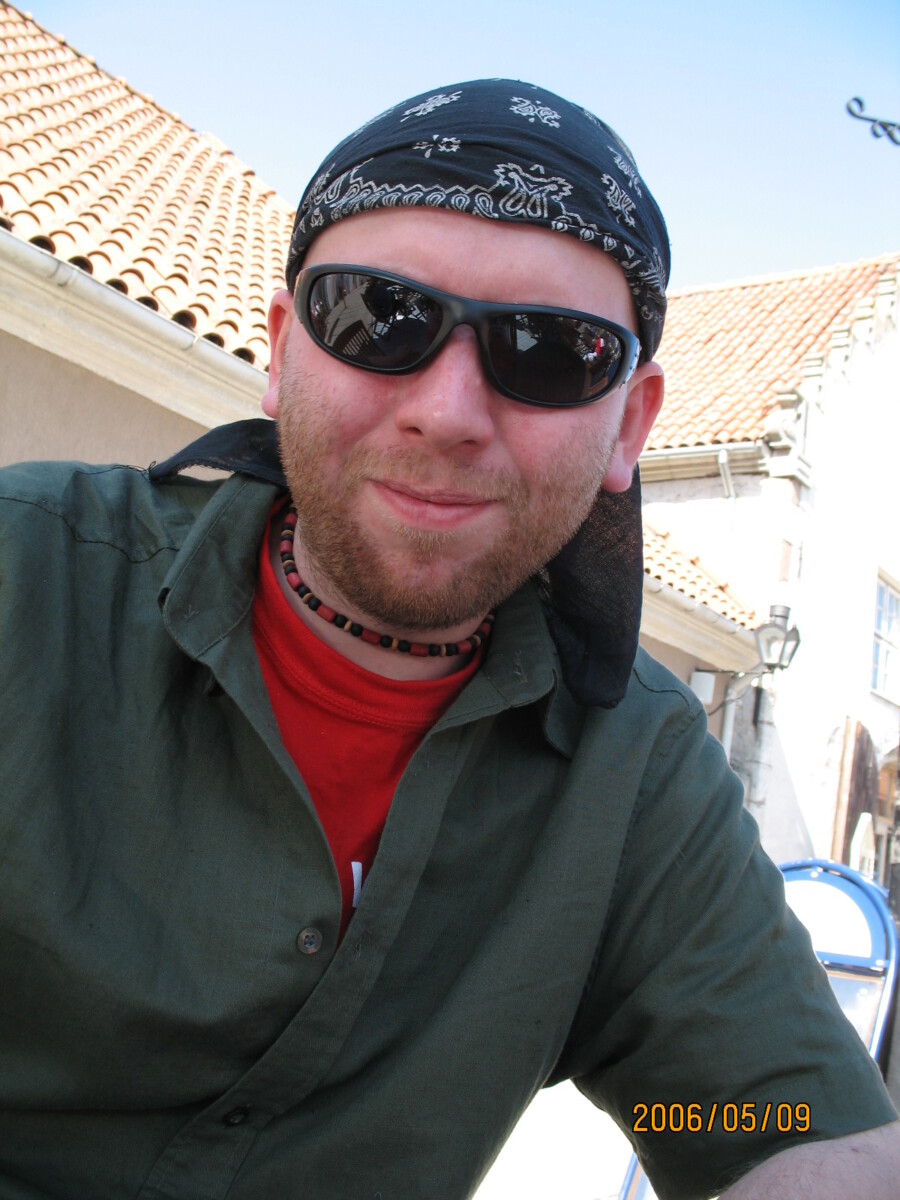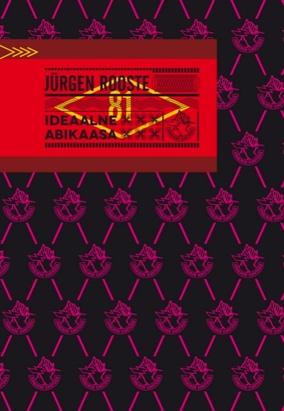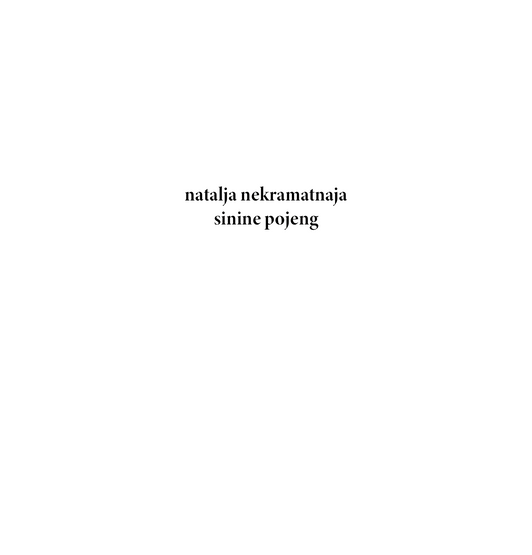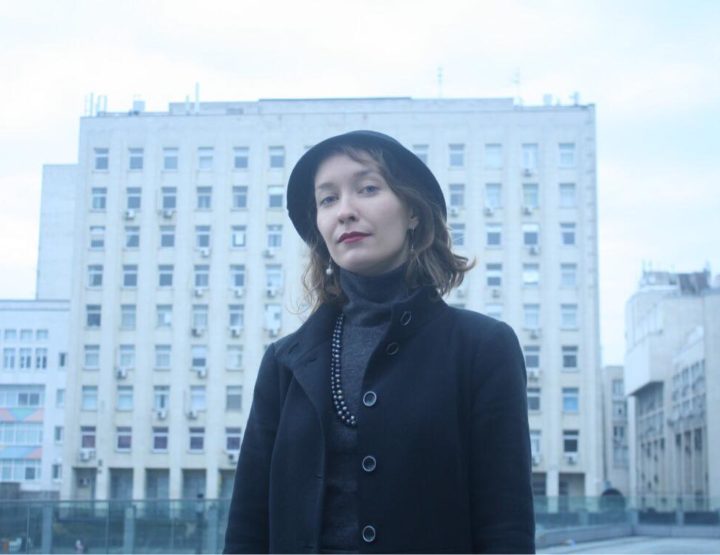The two laureates of the last annual poetry award both entered literature in the late 1990s; like Kristiina Ehin, Jürgen Rooste published his debut collection around the turn of the century, and both arrived as members of a youth group. Ehin has become one of the best-known names of the group founded in Tartu and called Erakkond, whereas Rooste started as a leader of Tallinna Noored Tegijad (Tallinn Young Creators). Both received an award for a book that reveals signs of their poetry becoming more serious and compact. At the same time the two poets are rather different: Ehin in her fresh manner continues a certain mainstream in Estonian poetry (besides winning the favour of critics, this has also secured her a wide readership), whereas Rooste represents far more peripheral (but more forceful) tendencies in Estonian poetry.
One keyword by which Jürgen Rooste is well known is ‘Taanilinn’ (Danishtown), or Tallinn, a town/living organism which he addresses in his poems with equal parts of love and hatred. His own life, too, is totally Tallinn-focused: he was born here in 1979, went to school and studied the Estonian language at the Tallinn Pedagogical University (now Tallinn University), and taught literature in a school; for the last five years Rooste has worked as the literary editor of the cultural weekly Sirp (in recent years also as executive editor). In spring 1998 a bunch of Tallinn Pedagogical University language students gathered into a creative group, Tallinn Young Creators (this was Tallinn’s reaction to the ‘groupings’ in Tartu: Erakkond and the Young Authors’ League had been established in 1997). The TYC nucleus was made up of Rooste, Wimberg (now known as the author of a collection of poetry and a novel, scriptwriter of the popular children’s programme Burattino Acts Again, and literary editor of the daily Eesti Päevaleht) and Ivar Sild (who is active as a poet, critic and journalist). It should be mentioned that the trio has frequently claimed their ideological (maybe aesthetic as well) model to be their professor Toomas Liiv. In 2000 TYC published a joint book, Some Were Not Willing, and then soon fell apart. Still, those whose wings carried them further have stayed in the literary arena to this day (besides that trio, other names survived as well, although Rooste could be considered the most outstanding author emerging from this particular group).
In late 1999 Rooste published his first collection, Sonnets, which received the Betti Alver award the following year for the best debut collection. The collection does not contain a single sonnet (Rooste is not in the least keen on classical forms, preferring impulsive and lavish free verse), and the title was arrogantly borrowed from one of the most remarkable debut works in Estonian literature, Marie Under’s Sonnets in 1917. The gesture in itself is interesting, as it indicates a relationship with tradition several times over – Rooste was referring to the carnivalesque and exuberant arrival of the Siuru literary group, established in 1917, which was one of the most sparkling self-manifestations of a new generation in Estonian literature. On the other hand, Rooste inevitably created an association with the group called Hirohall, which started a decade earlier, in 1988, reviving Siuru’s approach (Sinijärv, Kivisildnik, Kauksi Ülle, Ehlvest, Ränik). This can therefore be interpreted as a declaration of ‘permanent revolution’, taking the baton from the earlier rebels. His ambition was not in vain – Rooste’s Sonnets was enthusiastically received by Karl Martin Sinijärv, and since then Rooste and Sinijärv have presented their work between the same covers several times.
Echoes of Under have continued in Rooste’s subsequent titles: Veri valla 2000 (Blood Wide Open) reflects Under’s Verivalla (Bleeding Wound, 1920); Lameda taeva all 2002 (Under the Flat Sky) Under’s Lageda taeva all (Under the Open Sky); and Rõõm ühest koledast päevast 2003 (Joy of a Dreadful Day) Under’s Rõõm ühest ilusast päevast (Delight in a Beautiful Day). Only his latest collection, Ilusaks inimeseks (To Be a Beautiful Person), abandons this pattern. Rooste’s productivity, however, is more extensive; he has published his poems in various joint ventures: in 2000 in the collection by Rooste, Sinijärve and Asko Künnap, We Won’t Repeat Those Mistakes, in 2001 in the work of five authors, Pack of Cards, in 2002, together with Ivar Sild, under the pseudonym Tandem, in the collection titled Pegasus is a Little Perverse. He published a collection of children’s verse with Sinijärv and Wimberg in 2002 called Kolme päkapiku jõulud (Christmas of Three Dwarves) and contributed to the 2005 collection of children’s stories, Ruttu tuttu (Quick to Sleep). There have been more poems in various journals, not included in books, and a few short stories. Rooste’s text-generating energy has therefore been – especially in the early years of the century – most impressive, considering his activities as a critic as well.
The language and style of Jürgen Rooste’s poems are characterised by freely and forcefully flowing colloquial free verse; the tone is declarative and ecstatic rather than ‘poetically’ lyrical and reflective. Rooste’s poems leave the impression of a spontaneous river of associations, contained by a fixed self-image and a steady emotional tone that intensely oscillates between anxiety and intoxication, also containing ‘simpler’ sadness and joy. Rooste, with his poetic intonations, is certainly unique in Estonian poetry, although this cannot really be called a ‘unique poetic idiom’, as it is quite a synthetic type of poetic language that is always eager to borrow motifs, keywords and intonations, and blend them all into a dense, smoothly flowing alloy.
If we wish to look for some ‘nests’ or more solid points around which Rooste’s poetry revolves and which could describe it, we might find four or five.
Firstly, the above-mentioned Taanilinn. Rooste never uses the name Tallinn, which indicates a particular relationship with the city: Taanilinn is not merely some geographical space where the plots of Rooste’s poems unfold, but is instead a mental, even an existential, environment with which the poet communicates as if it were a being with a soul. Quite characteristic is the poem An open lovehate letter to Danishtown (in the book To Be a Beautiful Person), with the lines, “our love does not mean … tender romance-of-chivalry adoration from afar / it is a desperate scramble into each other’s tortured bodies / desire and fury that claw the flesh”. The poem ends, “one day you will demand my soul… what else am I going to demand of you / but your soul”. This is a passionate relationship with a town that constitutes a place of existence (locus existendi, as it were), and at the same time a stage of capitalist stupidity that evokes contempt in the poet. Rooste can, however, also be self-ironic about his image as the Danishtown-poet: in a cycle written for a special issue of the magazine Vikerkaar on urban topics (2004/4-5), he says: “pruul and väljataga [editors of the magazine – AP] thought I might produce a cycle of urban poetry / why on earth me // I am, after all, a stereotype urban poet / living in town and writing poems // this probably suits better than someone who / lives in the country and does not write / poems”.
Urban topics, in turn, are associated with an area known in Estonian literary space as ‘sociality’ – touching upon political and socially sensitive issues in poetry. At the time when Rooste and the Tallinn Young Creators arrived in literature, the term ‘close-to-life’ was adopted to describe the new manner. It was borrowed from a movement in the early 1930s that opposed the previous aesthetics and deemed it essential to focus on daily life and the social-political arrangement. The parallel is not quite precise, however, because at least in Rooste’s poetry the ‘sociality’ often turns into anarchic cries. Instead of constructivism typical of ‘sociality’, Rooste’s poems reveal a certain non-conformity without a concrete object, opposition to the cosy bourgeois way of life and society’s indifference towards those who do not measure up to being a ‘proper citizen’. This is naturally supplemented by Rooste’s innate tendency toward bohemianism, evident in many poems; in a few texts his rebelliousness borders on no less than terrorist notes (e.g. “ONE DAY I WILL GRAB MY GUN / AND RETURN TO ALL PLACES / WHERE WE WERE WRONGED” in the book Veri valla).
This line in Rooste’s poetry connects with various earlier cultural codes that opposed the social mainstream, to which Rooste refers and with which he seeks common ground. There are several traditions such as this (‘tradition’ in the given context might sound a bit strange but is nevertheless not wrong). Firstly, punk: the subtitle of the collection Under the Flat Sky is Texts from the Classics of Estonian Cyberpunk, which is obviously also self-ironical, although reflecting a certain mental connection with an ‘ideal punk’, which for Rooste, in the Estonian context, probably means the way the current article has tried to describe his poetry – urban, mutinous or a simple carnival-like attitude, anxious about society and suffering because of a lack of clear-cut ‘solutions’. We should here mention the anthology of punk poetry compiled by Rooste, Tagasi prügimäele (Back to the Scrap Heap 2000), where his own vision of punk is revealed: whoever talks about Estonian punk poets always mentions the trio Merca – Tõnu Trubetsky – Villu Tamme (plus names primarily known as punk singers), whereas Rooste has included poems of, for example, Arvi Siig, Ott Arder, Matti Moguci, and stretched the ‘punk line’ to the early 21st century young authors who were not necessarily connected with the still surviving punk movement. Although the concept was criticised by the ‘genuine punk’ Villu Tamme, Rooste in fact does not see punk poetry as a special literary institution (which would indeed be contradictio in adiecto), but rather as a kind of mental continuity from the spleen of urban Soviet youths of the 1960s up to the anxieties of today’s young people in the ultra-liberal Republic of Estonia. It is only logical that Rooste also wrote an introduction to the recently published Collection of Estonian Rap Texts. Another fact in the same vein is that Rooste was one of the translators of Allen Ginsberg’s collection America, published in 2003. The attitudes of the Beat generation are perhaps even more natural for Rooste than the more available punk; in any case his texts contain motifs whose connection with Beat seems quite relaxed. However, it must be noted that, in addition to the already mentioned motifs, Rooste’s poetry also contains sounds of Jamaican rasta- and ganja-culture, to say nothing of the quite ‘ancient’ rock ‘n’ roll as an innocent prototype of the urban counter-culture of the 20th century.
Rooste himself has been ‘rocking’ in the direct sense of the word: his poetry readings mostly take place with musical accompaniment. Rooste presents his poems accompanied by punk-rock music, either reciting or singing. His bands have been ‘Free Beer from Jamaica’ and ‘Good Life’, and he is currently working with guitarist Marko Martinson. The second half of his latest, award-winning book is a CD where Rooste and Martinson present an hour’s worth of texts; this CD gives an excellent opportunity to hear the original intonation of Rooste’s texts, including sounds described on the cover, such as, ‘humming, growling, wheezing, shouting, blabbering and other attempts at articulation’.
Still, it would be wrong to assume that Rooste’s poetry is nothing but ‘public’, ‘social’, ‘extrovert’ etc. In its innermost core, his poetry tells of a deep personal struggle between suffering and exaltation. True, Rooste’s poetic language is outwardly very diverse, attractive and impulsive, often even perhaps ‘too spontaneous’, careless, thrashing around wildly and aimlessly, but in fact this is rather an urgent attempt to capture something that cannot really be captured; this unattainable could be called ‘love’, but to call it that would be too trivial and banal. We could here refer to the text in his latest book, Willyou love me until the edge of eternity; it is addressed to a railwaystationguardgirl, a character cropping up in other poems as well, an embodiment of a mystical someone who would love unconditionally and whose love would constitute salvation. Another similar motif is ‘Christ-girl’, who appeared for the first time in the text Prelude to the Cross and Man in his début collection, where even the cover design is based on that motif – a woman crucified as the Saviour. The same motif appears in the poem When the Rooster Swears for the Third Time in the collection To Be a Beautiful Person.
If Rooste is significant in current Estonian poetry, it is primarily because he has given a fresh and convincing, believable and vivid, form to the old formula that brings together the unconditional desire for love and a yearning for death, and has added a social dimension. Rooste’s focal pain is pain because, in our contemporary world, everything can be ‘earned’, life has become labour which ‘earns’ you more or fewer nice things in life – but what, in that case, should we do with absolute love that essentially cannot be ‘earned’, being a gift and inevitability at the same time. Where, in the world of bartered values, to place love, the expectation of which is the only thing that keeps people going? It would probably not be an exaggeration to say that, in current Estonian poetry, Rooste poses this question most urgently of all, whereas it is significant that he is not asking the question merely in the name of his own personal existential anxiety, but is, in principle, asking in the name of all human beings, without becoming a declarative humanist (maybe only Triin Soomets is able to pose questions as sharply as Rooste, although she is, in comparison, more refined, more ‘cultivated’ and individual; it should be mentioned that Soomets is also one of Rooste’s favourite authors in current Estonian poetry). Rooste does not offer salvation, but rather the knowledge that we each have been born ‘a beautiful person’, in the words of the title of his collection of poems (and its ‘title’ poem Kindling the Sparkle of the Morning Star), but we have not remained like that – we love optionally and feel pain because of this; we desire pleasure and attention, but constantly clash with their impossibility. In that poem, Rooste says: “let this not ease his pain by a gram / let it not give any sense to a single moment you condescend to exist / let it not bring reconciliation and balance … but I am acquitting you today / you were born beautiful persons”. Rooste’s poetry, therefore, contains Occidental networks of terms with long traditions that are connected with Christian Passion, but they have been revived in the 21st century context – i.e. in the context of today’s Estonia and its contemporary intellectual context — where it is more honest to offer consolation to ‘people in hopelessness’ instead of hope of salvation.
Rooste’s poetry is changing. The poet’s hypertrophied and self-ironical self-image of the “Veri valla” period (“I am karl marx / with the body of arnold swarzenegger / with the brains of immanuel kant / with the bust of dolly parton at her best / with the voice of robertino loretti”) has changed to that of a poet who feels that “I now seem to be torn straight out of a literature textbook”, and who feels vague guilt about not being able to fit into the etiquette of literary undertakings. The self-irony is still there but it is more melancholic. The back cover of the collection To Be a Beautiful Person contains the phrase “what’s the use of poetry”. This refers to Rooste’s poem of the same title (not included in the book), and reveals the doubt in Rooste’s recent texts about the point of writing poems: does poetry save the world/people? The obvious answer is ‘no’, but it is also clear that there is some point at least in writing poems. Rooste’s poetry is becoming (beginning with some texts published in magazines in 2004) more precise and transparent, with fewer illusions, without however losing its initial impulse, or desire for the ultimate painful pleasure and the ultimate unconditional love. From its initial fiery sizzle, Rooste’s poetry has moved to an increasingly intense glow. With this kind of poetry it would be strange to wish its continuing development, because poetry is not a mere text, but a sign of human existence. However, to wish that his poetry would develop towards a more peaceful glimmer would not harmonise with the spirit of this poetry either.
© ELM no 23, autumn 2006





